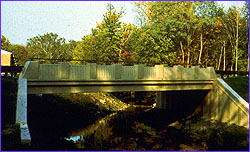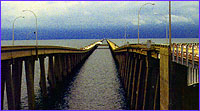 |
Beam Bridge
In its most basic form, a beam bridge consists of a horizontal beam that is supported at each end by piers. The weight of the beam pushes straight down on the piers. The beam itself must be strong so that it doesn't bend under its own weight and the added weight of crossing traffic. When a load pushes down on the beam, the beam's top edge is pushed together (compression) while the bottom edge is stretched (tension). Try It! What happens when a load pushes down on a beam bridge?  Take a flat eraser or a small sponge and slice a shallow notch across the top
and bottom. Create a beam bridge by supporting each end of the eraser (or
sponge) with a stack of books. Press down on the center of the bridge. What
happens to the top and bottom notches? Notice how the top notch squeezes
together in compression, while the bottom notch spreads apart under tension.
Take a flat eraser or a small sponge and slice a shallow notch across the top
and bottom. Create a beam bridge by supporting each end of the eraser (or
sponge) with a stack of books. Press down on the center of the bridge. What
happens to the top and bottom notches? Notice how the top notch squeezes
together in compression, while the bottom notch spreads apart under tension. Pre-stressed concrete is an ideal material for beam bridge construction; the concrete withstands the forces of compression well and the steel rods imbedded within resist the forces of tension. Pre-stressed concrete also tends to be one of the least expensive materials in construction. But even the best materials can't compensate for the beam bridge's biggest limitation: its length. The farther apart its supports, the weaker a beam bridge gets. As a result, beam bridges rarely span more than 250 feet. This doesn't mean beam bridges aren't used to cross great distances—it only means that they must be daisy-chained together, creating what's known in the bridge world as a "continuous span."
(back to intro) (next bridge description: suspension bridge) Photos: (1) Rita Serderian-Precast/Prestressed Concrete Institute; (2) Gulf Engineers and Consultants, Inc. Build A Bridge | Resources | Guide | Transcript | Bridge Home Editor's Picks | Previous Sites | Join Us/E-mail | TV/Web Schedule About NOVA | Teachers | Site Map | Shop | Jobs | Search | To print PBS Online | NOVA Online | WGBH © | Updated October 2000 |

